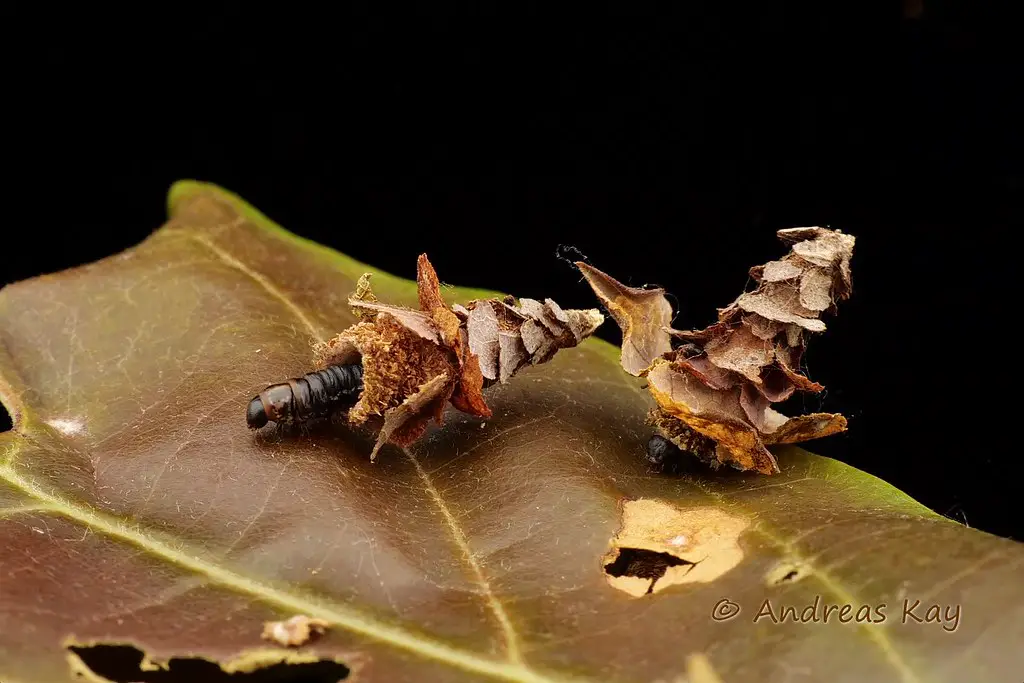Bagworms are unique insects known for their impressive ability to create and live within protective cases or “bags.” These bags, often resembling tiny dangling pinecones, offer them concealment and protection from predators. Although intriguing, bagworms are considered pests in many landscapes and gardens due to the damage they can inflict on trees and shrubs. In this blog post, we’ll explore the intricate details of bagworms, their life cycle, their impact on plants, and ways to control their population.
Biology of Bagworms
Identification and Appearance
Bagworms are part of the family Psychidae. The larval stage is what gardeners most commonly encounter. Larvae construct their bags using silk and material from the host plant, such as leaves, twigs, and needles, making each bag unique to its environment.
Adult male bagworms transform into moths with wings, while female bagworms remain wingless, legless, and largely inside their bags. The males fly around in search of females, while females stay within their bags, where they will lay their eggs.
Habitat and Behavior
Bagworms are found across the United States, particularly in the eastern states. They primarily feed on conifers but have been known to infest deciduous trees and shrubs as well.
Life Cycle of Bagworms
Understanding the life cycle of bagworms is essential for effective control:
- Egg: Eggs are laid inside the female’s bag, where they overwinter.
- Larva: In late spring, larvae emerge and begin constructing their bags. As they feed and grow, they enlarge the bags.
- Pupa: In late summer, larvae attach their bags to a twig and pupate inside.
- Adult: Male bagworms emerge as moths to mate with females, who remain in their bags. After mating, the female lays eggs inside her bag, and the cycle continues.
Impact on Plants
Bagworms are considered pests due to their feeding behavior:
- Defoliation: Larvae feed on leaves and needles, leading to defoliation that can weaken or even kill the plant if the infestation is heavy.
- Aesthetic Damage: The presence of the bags themselves may be considered unsightly on ornamental plants.
Control and Management
Managing bagworms requires a combination of monitoring and intervention:
Monitoring
Regular inspection of susceptible plants, especially during the late spring and early summer when larvae are active, is essential.
Physical Removal
For light infestations, picking the bags by hand and disposing of them can be an effective control method.
Biological Control
Natural predators, such as birds and parasitic wasps, can help control bagworm populations. Introducing these beneficial organisms can reduce reliance on chemical interventions.
Chemical Control
In severe cases, insecticides might be necessary. Timing is critical, as insecticides are most effective on young larvae. Consult with a local extension service for the best timing and product recommendations in your area.
Cultural Practices
Maintaining healthy plants through proper watering, fertilization, and pruning practices can make them more resistant to bagworm infestations.
Conclusion
Bagworms are fascinating creatures with their bag-building behavior and camouflage abilities. While they contribute to the ecosystem as a food source for various predators, their infestation can cause significant damage to ornamental and landscape plants.
Understanding the biology and life cycle of bagworms can guide gardeners and landscape professionals in implementing effective control strategies. Combining physical removal with biological and chemical controls, where necessary, ensures that our gardens remain both beautiful and bagworm-free.
By respecting their place in nature and managing them judiciously, we can appreciate the artistry of these tiny architects without sacrificing the health and aesthetics of our cherished green spaces.

